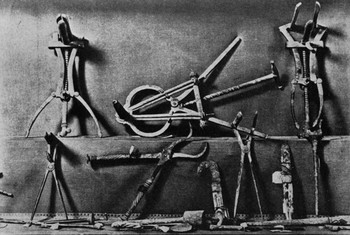|
|

The Destruction of Vesuvius
|
On
This Site
|
|
• Ancient Rome
|
|
Share This Page
|
|
|
|
|
|
|
Follow This Site

|
 |
|
|
The cities of Pompeii and Herculaneum survive because they were overwhelmed in the blink of an eye. The people and animals died in an instant, but their culture has survived.
 Pompeii had 20,000 people at its height of population, with many of those people owning or operating vineyards and orchards. Manufacturing was big business as well. Pompeii had 20,000 people at its height of population, with many of those people owning or operating vineyards and orchards. Manufacturing was big business as well.
Herculaneum had 5,000 people on average but was a favorite summer destination of rich Romans. The city had large, expensive and extravagant villas and a spectacular array of baths.
Both of these cities, which had been built up for hundreds of years, ceased to exist in one frightening, astonishing day.
 At almost precisely noon on August 24, 79, nearby Mount Vesuvius, a volcano that been quiet for hundreds of years, suddenly spewed forth a huge explosion that rocked the countryside for a huge number of miles around and creating a mushroom cloud of ash and debris 10 miles high. Fire and debris rained on Pompeii, and most people fled. A few, perhaps as many as 2,000, stayed, hoping that things wouldn't get any worse. It did. The very next morning, a cloud of toxic gas, fumes from the volcano, wafted through the city, killing all who breathed it. A rockslide followed, burying the dead where they lay. At almost precisely noon on August 24, 79, nearby Mount Vesuvius, a volcano that been quiet for hundreds of years, suddenly spewed forth a huge explosion that rocked the countryside for a huge number of miles around and creating a mushroom cloud of ash and debris 10 miles high. Fire and debris rained on Pompeii, and most people fled. A few, perhaps as many as 2,000, stayed, hoping that things wouldn't get any worse. It did. The very next morning, a cloud of toxic gas, fumes from the volcano, wafted through the city, killing all who breathed it. A rockslide followed, burying the dead where they lay.
Herculaneum was much the same story, with the death-dealing blow being a monstrous cloud of hot ash and gas surging through the city, killing all who had stayed. Not long after, a massive rock- and mudslide engulfed the city.
 Among the thousands killed as a result of this catastrophe was the famed Roman historian Pliny the Elder, who left the boat he was traveling on, went ashore to investigate, and then died after breathing in the toxic gas that remained. His nephew, Pliny the Younger, provided many of the details from one of the few eyewitness accounts we have to this tragedy. Among the thousands killed as a result of this catastrophe was the famed Roman historian Pliny the Elder, who left the boat he was traveling on, went ashore to investigate, and then died after breathing in the toxic gas that remained. His nephew, Pliny the Younger, provided many of the details from one of the few eyewitness accounts we have to this tragedy.
Pliny the Younger tells us that the volcanic eruption lasted 18 hours, emitting huge amounts of rock, ash, burning stone, and toxic gas. Pompeii was buried under 14 feet of ash. Herculaneum was buried under more than 60 feet of mud and volcanic remains.
Some of the people who escaped the carnage came back a few days later, but not much was left to recover. These people found new homes, and the cities of Pompeii and Herculaneum stayed buried and eventually became forgotten.
Seventeen hundred years later, the cities were rediscovered, a little at a time, with chance discoveries and then with a concerted effort to uncover the "lost civilizations."
 In all, the remains of 2,000 people were found at Pompeii. Those people died of suffocation. The volcanic ash covered their bodies and hardened them, preserving the outlines. Other signs of life, including many ordinary objects like tables and chairs and vases, were found intact as well, covered by ash and hardened so as not to decay. The same has been found at Herculaneum, to a lesser degree. In all, the remains of 2,000 people were found at Pompeii. Those people died of suffocation. The volcanic ash covered their bodies and hardened them, preserving the outlines. Other signs of life, including many ordinary objects like tables and chairs and vases, were found intact as well, covered by ash and hardened so as not to decay. The same has been found at Herculaneum, to a lesser degree.
 We know much about how these people lived and certainly how they died. We know this because of the devastation left behind by the ash, rock, mud, and gas spewed forth by Vesuvius 2,000 years ago. We know much about how these people lived and certainly how they died. We know this because of the devastation left behind by the ash, rock, mud, and gas spewed forth by Vesuvius 2,000 years ago.
The volcano is still active today. It last erupted in 1944. That eruption wasn't a major one and caused little damage, but the one in 1631 was huge and ripped through the surrounding countryside. Based on written records, earthquake-watchers suspect that another major eruption is just around the corner. Today, 700,000 live in the area devastated in 79.
|
|